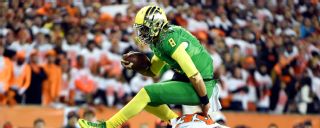|
Chantel Jennings touched on Sports Illustrated's feature on college football branding by Andy Staples -- leading with college football's most recognizable brand: Oregon -- but as a witness to the Ducks' embrace of rebranding in the late 1990s, I have a couple of thoughts. First, Staples makes the case that Oregon's branding began when Rich Brooks, after years of fits and starts, finally created a winner in the 1990s, a true rival for Northwest supremacy with Washington. Not sure I'd agree with that. Every team needs winning to establish credibility, but Oregon scrapped and clawed toward respectability much like any other team that followed the same difficult path against college football blue bloods. It didn't distinguish itself as different until two things happened: 1. In 1998, the Moshofsky Center, the first indoor practice facility in the Pac -10, opened; 2. The Ducks changed their traditional logo and started tinkering with their uniforms in the late 1990s. Staples covers this, paying particularly note to the Ducks' "lightning yellow" uniforms that debuted in 2003 at Mississippi State, which made them the "Fighting Hi-Liters," according to ESPN's Ivan Maisel. That was a noteworthy moment because the uniform couldn't possibly have been made in the hopes of finding widespread appeal. They were intentionally weird. Ugly, even. The goal was to get attention, not impress everyone. This was about divorcing the program from college football's most important cultural signifier at the time: Tradition. The goal, yes, was to thumb their noses at traditionalists. I recall asking then-coach Mike Bellotti for his personal take on "lightning yellow." Bellotti was never much of a PR dissembler. He admitted that, no, they weren't exactly his favorite. But then he said something meaningful: "They're not for me. They are for the players." That was a major move in Oregon's rebrand. The Ducks weren't recruiting using history and tradition and the team your granddad rooted for. They were recruiting for the now, for the new, for players who want to look slick, not vanilla traditionalist like Penn State, Alabama or even USC. It actually wasn't that far from what Miami did when it embraced an urban/youth cultural appeal that ran afoul of the buttoned-down types. Obviously, it became a great strategic shift for the Oregon program, one that was initially mocked everywhere and now is copied by just about everybody. Winning is still the unquestioned prime directive, and wearing a quirky uniform while getting pummeled just makes a program look ridiculous. But college football is big business, and if you are not treating it as the multidimensional entertainment industry it is, you will be left behind.
|

